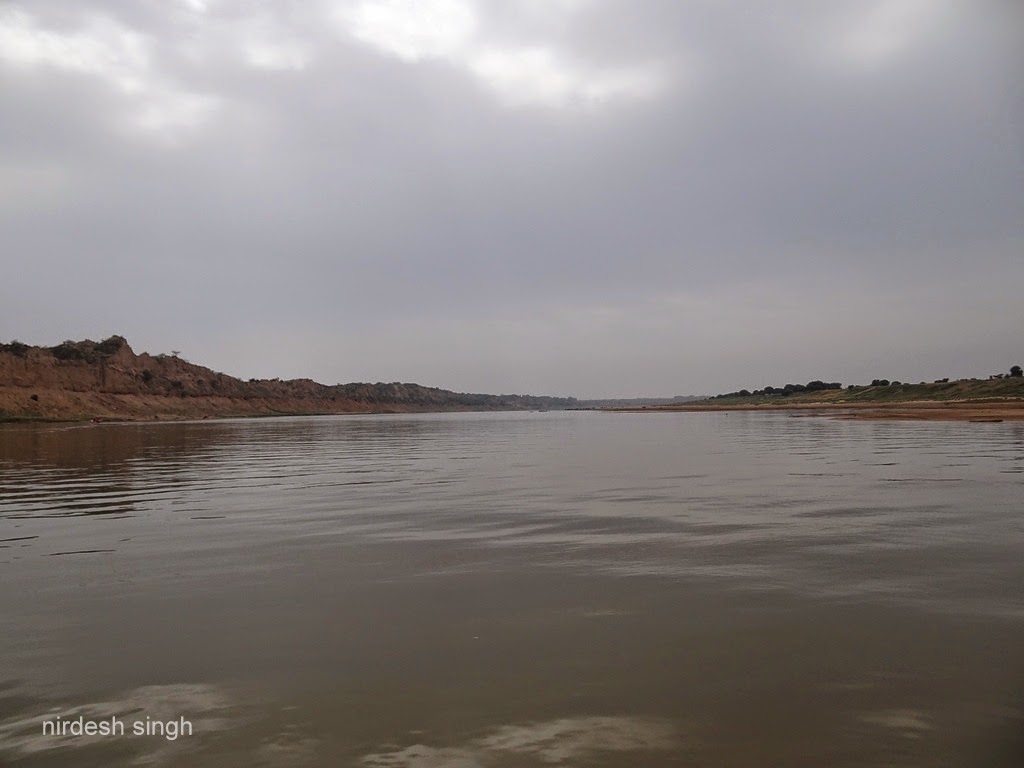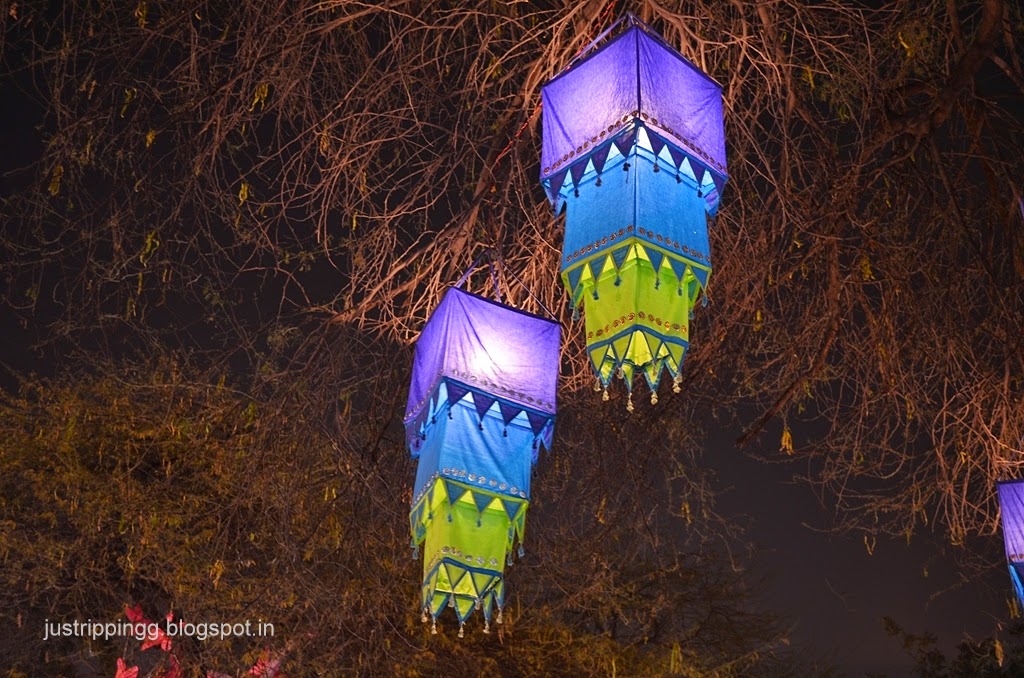Last time you
missed taking a ride on Chambal at Ater Fort in Bhind. On the Bhind side the boat
experience is adrenal inducing unadulterated fun; it is just like being a Baghi
in the ravines of the 80s. The boat is powered by the currents and oars. For
company and safety, if you are lucky, you will have both men and women wielding guns. And
since the boat is packed, the buffalo does not find a place in the boat; it is
tied to the boat and towed away even as it floats on the water.
 |
| Gharials in Chambal River at Dholpur |
 |
| Chambal Safari - Bhind Style Photo Courtesy - Vipin Gaur |
Next opportunity comes your way a year later. You are in Dholpur discovering unknown gems and tripping down memory lanes. After reestablishing associations you drive few kilometers south towards Chambal River. Just beyond the Shergarh ramparts, as NH3 dips towards the bridge, you can see the sign for Chambal Safari on the left. A winding road takes you down to the banks of the river.
 |
| Chambal Safari at Dholpur Rajasthan |
 |
| New Bridge of Chambal |
 |
| Shergarh Ramparts Overlooking the Chambal |
Here on the banks
there are two boat launch points. One belongs to a local heritage hotel and the
other is for the general public run by Dholpur city. The rates are displayed. The
lone boat is gone with visitors. It is time to look around as we wait. On the
left, an incomplete bridge is making its way from Morena side to Dholpur side.
On our left, just beyond you can see a huge squat and strong structure. We are
informed that it is the Rani Ghat probably used by the royal women for bathing
or just hanging out during summer evenings. The structure has miraculously escaped
getting drilled by the bridge pillars. Just behind on your left perched high
on the mud ravines are the ramparts of Shergarh which you saw on the way.
On your right is a
halfbridge leading to some Irrigation Department structure. Next to it is the
funky looking futuristic functioning bridge. Now this bridge has some neat
looking never seen before pillars. While some look like thin walls of concrete,
others have spread out pillars forming a triangle. High up the trucks and cars
get on with their business.
The boat soon
arrives. Here the boat ride is sanitized. You grab a jacket, strap it on, and
you are all set to see some gharials. And no, there is no buffalo hooked to your
boat.
Seeing the wisp of
an oily stinky trail that Yamuna is, it is always a marvel looking at rivers
that actually look and feels like rivers. Chambal is alive; the water is
actually clean and flowing. The centuries old curse and the river being
‘unholy’ probably saved the river. Later the baghis ensured that the river
remained out of bounds. The perennial river with pristine water is a marvel
while Himalaya fed Ganga and Yamuna are dying. As you glide over the calm waters,
it is difficult to imagine that these gentle lapping waters could have seen so
much blood, death, terror and revenge.
We head westwards
where chances of sighting gharials and crocodiles are more. Yes, Chambal is
known for its Gharials. Gharials (Gavialis gangeticus) belong to the
crocodilian family and are distinguished by their long snouts. Gharials were
found across India but now about 235 of them survive in the world (source:
Wiki). The Chambal National Sanctuary is playing its role in protecting and
breeding gharials. And here on the banks of Chambal you can see gharials in
their natural habitat.
The outboard motor chatters away as we cross the bridge leaving behind a wake. Looking behind you can see the ramparts of Shergarh receeding. It sure is a perfect setting but the bridge and development will ensure the view will not last. On the left, ravine mud walls tower over the river. You can see people on the banks with their livestock. Birds go pecking in the water looking for fishes. It is a cloudy day with sun making an appearance every now and then. Gharials usually come out to sunbathe. Will they come out today?
 |
| Mud Ravines providing the perfect bacdrop to Gharials in Chambal |
And then the
boatman points out two gharials on the left. They are kind of far off. The
gharials are shy and disappear into the water seeing the boat or hearing
the motor. So the option is either to cut off the motor and try to paddle
towards the gharials or use the zoom camera. You try to do both. With the motor
off, you zoom in. The boat bobs and it not easy photographing them. The
reptiles do look magnificent. Sometimes they will catch the sun and the scaly
back would glimmer like gold. They look adorable and are not known to feed on
humans. They prefer fish.
We move ahead. It
is time to eyeball some crocs. It is your lucky day. And we soon find one - this time on the right
bank. Now the crocodile does look mean and fearsome. In comparison, the gharials
look almost toyish and pet-like. You are not sure how crocs and gharials behave living together in the same waters - is there brotherhood or are they sworn enemies like lions and
cheetahs? The crocodile slides into the water – not sure if it felt shy in our
presence or suddenly felt like chomping on some city slickers. You keep looking
in the water waiting for the croc to emerge under your boat.
Further up are the
dolphins. The previous batch of visitors had returned without any dolphin
sighting. You ask the boatman to return but not before you enjoy the setting one
last time.
 |
| Paan Singh Tomar and his Band of Men - Photo Courtesy santabanta.com |
This is bliss. The
bridge is far behind; we have turned a bend in the river. When the motor dies,
all becomes quiet. Birds coo, fishes create ripples in the water. In the
distance you can see a group of men wading through the river. That is unmistakably
Paan Singh Tomar and his band of baghis. Tall, nonchalant and proud; khaki
fatigues, gun over the shoulder. On the other shoulder, a bullet belt is casually
slung over. The army training and discipline is apparent. If Paan Singh Tomar, a national steeplechase champion, wanted
to, he could have leapt over the river in a single bound. He does not even
notice you as you stare wide-eyed. You forget to even get scared. And then the
men disappear in the badlands.
India is about
films and romanticism. In the deserts of Rajasthan you will see a swaying colorful
Yana Gupta resplendent in a mirror dress bring you water in a pot held precariously
over her head as lie sputtering to death. Here in Chambal you will see baghis emerge at every bend. Of
course, Yana is a figment of imagination as the mirages in desert and here in Chambal the baghis are long gone. Some are
dead and some have retired after the government offered them amnesty. Now people
prefer to fight their battles in the courtrooms.
The world around
the Chambal has changed little since the times of Mahabharat when Chambal was
called Charmanyavati and the Pandavs lost out in a dice game in the general
vicinity. Kunti left the baby Karn floating on the river. Draupadi cursed the
river and people called it unholy. Dacoits are gone but a new danger is looming
that might change the river and the area completely. Mafia is at work dredging
the sand, while the mud ravines that give Chambal the unique look, are being leveled. What is wrong with the people today? You just hope Chambal will overcome the modern adversaries too and continue its
beautiful and perennial ways into the next century. Next time you will meet Chambal in Kota.















































